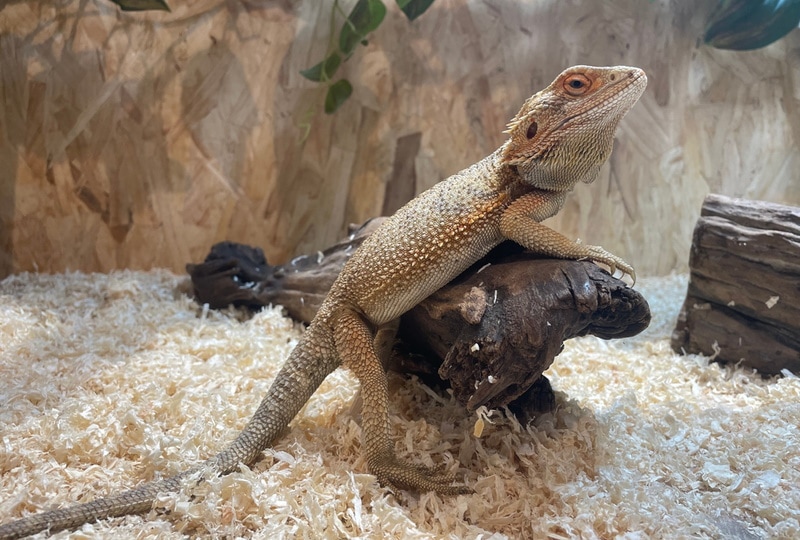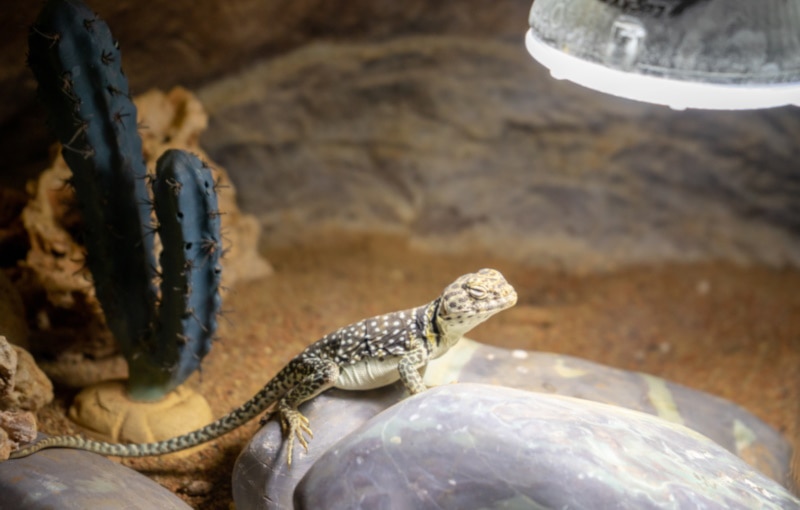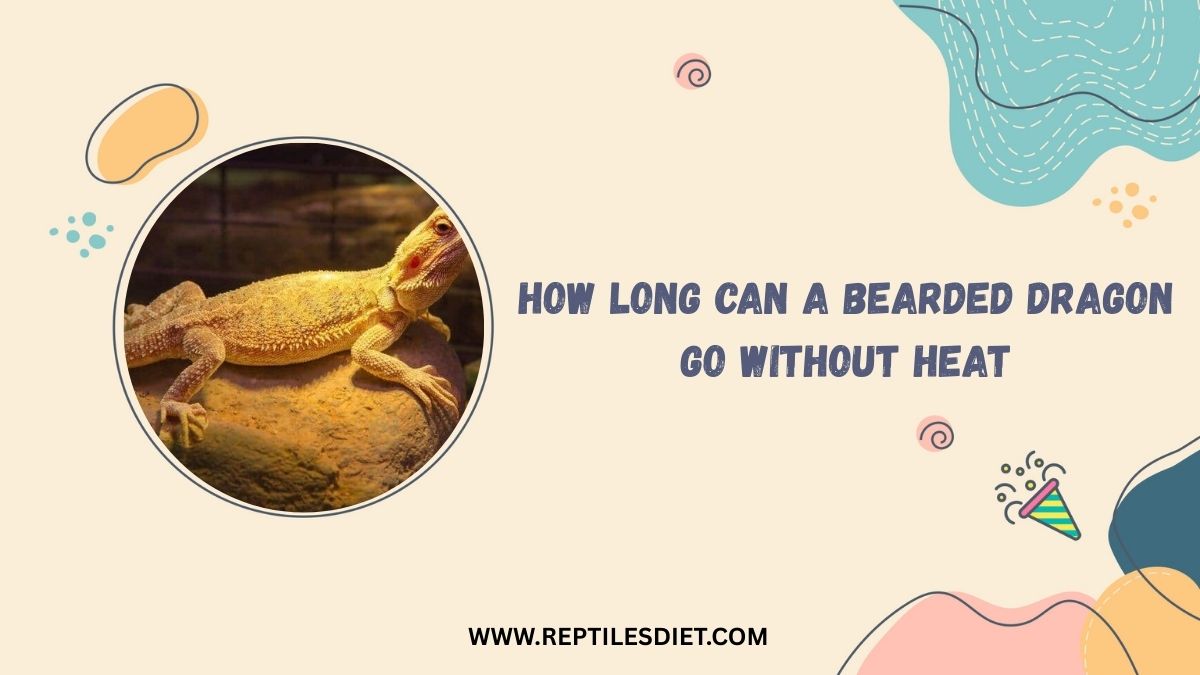Bearded dragons, native to the arid deserts of Australia, are ectothermic (cold-blooded) reptiles that rely on external heat sources to regulate their body temperature.
A bearded dragon can survive without heat for up to 24 hours if the ambient temperature stays above 65°F (18°C). Beyond this, health risks increase, so restore heat promptly.
This article explores these questions in depth, drawing on expert insights and practical advice to help bearded dragon owners maintain optimal care.
Why Heat Is Essential for Bearded Dragons
Bearded dragons require external heat to maintain their body temperature, as they cannot generate heat internally like mammals. In the wild, they bask in the sun to warm up and seek shade to cool down, maintaining an optimal body temperature for essential physiological processes.
According to veterinarian Dr. Rebecca MacMillan, heat is necessary for digestion, metabolism, and blood circulation, as it enables blood to deliver oxygen and nutrients to cells while removing waste products. Heat also mimics their natural environment, where they spend significant time basking under the sun.
Without adequate heat, bearded dragons can experience serious health issues, including digestive problems, lethargy, weakened immune systems, and, in extreme cases, fatal consequences.
Prolonged exposure to cold can even induce brumation, a state of dormancy similar to hibernation, which can be risky for pet dragons, especially if they are young, unwell, or not properly prepared.
Ideal Temperature Requirements

To thrive, bearded dragons need a temperature gradient within their enclosure, allowing them to move between warmer and cooler areas as needed. The specific temperature requirements vary by age:
- Adult Bearded Dragons (18 months and older): The basking area should be maintained at 90–93°F (32–34°C), with the cooler end of the enclosure at 80–90°F (27–32°C).
- Juvenile Bearded Dragons (3–17 months): These dragons require slightly higher temperatures due to their faster metabolism and growth, with a basking area of 95–105°F (35–41°C) and a cooler area of 80–90°F (27–32°C).
- Nighttime Temperatures: A natural temperature drop at night is acceptable, mimicking the wild environment. As long as the enclosure does not fall below 65°F (18°C), supplemental nighttime heating may not be necessary. However, if the ambient temperature drops lower, a non-light-emitting heat source, such as a ceramic heat emitter, is recommended to avoid disrupting their circadian rhythm.
The enclosure should also maintain humidity levels between 30–40% to replicate their arid natural habitat. A high-quality thermostat and multiple digital thermometers are essential for monitoring and maintaining these conditions accurately.
How Long Can a Bearded Dragon Go Without Heat?
Bearded dragons can tolerate a lack of supplemental heat for a limited time, provided the ambient temperature remains above a critical threshold. According to multiple sources, a bearded dragon can generally survive without heat for up to 24 hours if the room temperature stays above 65°F (18°C). However, this duration depends on several factors:
- Age and Size: Juvenile and hatchling bearded dragons are more vulnerable to cold than adults due to their smaller body mass and higher metabolic demands. They may tolerate cold for a shorter period.
- Health and Condition: Healthy, well-nourished dragons can withstand cooler temperatures better than those that are sick, injured, or malnourished.
- Ambient Temperature: The colder the environment, the faster a bearded dragon will lose body heat, potentially entering a state of torpor or brumation.
- Acclimation: Dragons accustomed to slight temperature fluctuations may handle brief periods without heat better than those kept in consistently warm conditions.
Prolonged exposure to temperatures below 65°F (18°C) can lead to health issues such as sluggishness, refusal to eat, darker skin coloration, and digestive complications. If the lack of heat extends beyond 24 hours, the risks increase significantly, potentially leading to serious conditions or even death.
Emergency Measures During Heat Loss

If a bearded dragon’s heat source fails due to a power outage, a burnt-out bulb, or other issues, owners must act quickly to maintain a safe temperature. Here are some expert-recommended strategies to keep your bearded dragon warm during an emergency:
- Insulate the Enclosure: Wrap the enclosure with blankets or towels to slow heat loss. This helps retain existing warmth, though it won’t prevent all heat from escaping.
- Use Alternative Heat Sources: Place covered hot water bottles or heat packs near (but not in direct contact with) the dragon to provide localized warmth. Ensure these are safe and cannot be torn or chewed.
- Relocate to a Warmer Area: Move the enclosure to a warmer room in the house to take advantage of ambient heat. If possible, avoid areas with drafts or extreme cold.
- Hold the Dragon Close: Wrap the bearded dragon in a warm blanket and hold them against your body to share body heat. This is a temporary measure and should be done carefully to avoid stress.
- Avoid Feeding: Do not feed the dragon during periods without heat, as they cannot digest food properly without adequate warmth. Wait until proper basking temperatures are restored.
- Monitor for Cold Stress: Watch for signs of cold stress, such as lethargy, shivering, reduced activity, or darkened skin. If these symptoms persist, consult a reptile veterinarian immediately.
For longer-term solutions, consider using backup heat sources like ceramic heat emitters, radiant heat panels, or heat cables, which can serve as supplemental or emergency heating options. Always have spare bulbs and a backup power source, such as a portable generator, on hand to mitigate prolonged outages.
Preventing Heat-Related Issues
Prevention is the best way to ensure your bearded dragon’s safety. Here are some proactive steps to maintain consistent heating:
- Invest in Quality Equipment: Use high-quality heat lamps with ceramic fixtures and a reliable thermostat to maintain stable temperatures. Digital thermometers with probes are more accurate than analog ones and should be placed at both the basking and cooler ends of the enclosure.
- Use a Timer: A timer can automate the on/off cycle for heat lamps (typically 12 hours on, 12 hours off) to maintain consistency and prevent human error.
- Keep Backup Supplies: Stock extra bulbs, heat lamps, and thermometers to quickly replace faulty equipment. Air-activated hand warmers or self-heating mats can also be useful in emergencies.
- Monitor Regularly: Check temperatures daily to ensure they remain within the optimal range. Use multiple thermometers to verify accuracy and detect any false readings.
- Prepare for Power Outages: A battery-operated heater or portable generator can provide temporary power during outages. Ensure these are set up safely to avoid hazards.
- Avoid Light-Emitting Heat Sources at Night: If supplemental nighttime heating is needed, use ceramic heat emitters, which provide warmth without light to preserve the dragon’s sleep cycle.
When to Seek Veterinary Help
If a bearded dragon is without heat for more than 24 hours or shows signs of distress (e.g., lethargy, refusal to eat, or darkened skin), consult a reptile veterinarian immediately. Young or unhealthy dragons are particularly vulnerable, and prolonged cold exposure can lead to serious health complications. A vet can assess the dragon’s condition and provide guidance on restoring proper care.
FAQs
How long can beardies go without a heat lamp?
Beardies can last up to 24 hours without a heat lamp if the room stays above 65°F. After that, they risk getting sick, so act fast!
What happens if bearded dragons don’t get enough heat?
Without enough heat, bearded dragons get sluggish, stop eating, and can’t digest food. Their immune system weakens, and long-term cold can cause serious health problems.
How to keep bearded dragon warm without a heat lamp?
Wrap their tank in blankets, use hot water bottles, or hold them close for body heat. Move them to a warmer room, but avoid feeding.
How long can lizards survive without a heat lamp?
Most lizards, like bearded dragons, can survive 24 hours without a heat lamp if it’s above 65°F. Longer periods risk health issues, so restore heat quickly.
What is the lowest temperature a bearded dragon can tolerate?
Bearded dragons can handle 65°F for a short time, like 24 hours. Below that, they get too cold, risking sluggishness, poor digestion, and serious illness.
What happens if my bearded dragon gets too cold?
If too cold, your bearded dragon may become lethargic, stop eating, or darken in color. Prolonged cold can lead to digestive issues or serious health problems.
How long can a bearded dragon go without a UV bulb?
Bearded dragons need UVB for vitamin D and health. Without it, they can last a few days, but longer risks weak bones and serious health issues.
Does my bearded dragon need a heating lamp 24/7?
Beardies need a heat lamp during the day for basking. At night, they’re fine above 65°F without light, but use a ceramic heater if colder.
Conclusion
Bearded dragons can generally tolerate up to 24 hours without supplemental heat if the ambient temperature remains above 65°F (18°C). However, this duration varies based on the dragon’s age, health, and environmental conditions. Prolonged exposure to cold can lead to serious health issues, making it critical for owners to act quickly in emergencies. By insulating the enclosure, using alternative heat sources, and maintaining backup equipment, owners can protect their bearded dragons from thermal stress. Regular monitoring, high-quality equipment, and preparedness are key to ensuring these fascinating reptiles remain healthy and comfortable, even in challenging situations. For further advice, consult a veterinarian specializing in reptiles to address any specific concerns about your bearded dragon’s care.

